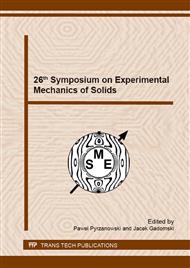p.212
p.218
p.225
p.232
p.238
p.244
p.250
p.255
p.261
Determination of Mechanical Properties of Rat Aorta Using Ring-Shaped Specimen
Abstract:
Ring-shaped specimen is commonly used in tests for determination of mechanical properties for arteries in hoop direction, especially for small mammals such as rats or mice. Although ring test is a lot more convenient than the tests concerning strip specimens, interpretation of the experimental data might be inconclusive – it is difficult distinguish whether it's still straightening up or the actual tension begins. The basic problem is to properly define initial length of specimen, which is essential for strain calculation. The purpose of this study was to evaluate various methods for strain evaluation. Ten Wistar Albino Glaxo male rats (3 months old, body weight about 200g) were sacrificed by decapitation and arteries were immediately removed. Three specimens, each approximately 2–3mm long, from each rat were excised adjacent to the aortic arch. Couple different initial lengths, as well as Digital Image Correlation based extensometer results were used for strain-stress response calculations. In addition a 3D Finite Element model, with an Ogden constitutive model based material, was made for deeper investigation of specimen behavior. This study has shown that the testing procedure for determination of mechanical properties of arteries, based on ring-shaped specimen, is prone to errors. Stiffness calculations are very sensitive to the choice of initial length of the specimen. As the use of DIC proved to give very good correlation with experimental data this method will be used in further studies.
Info:
Periodical:
Pages:
255-260
Citation:
Online since:
August 2015
Price:
Сopyright:
© 2016 Trans Tech Publications Ltd. All Rights Reserved
Share:
Citation:


